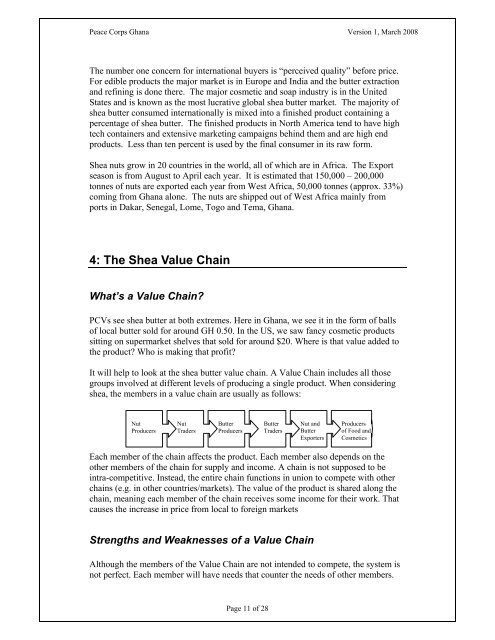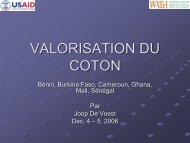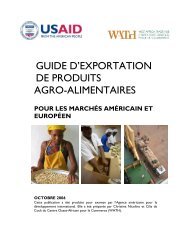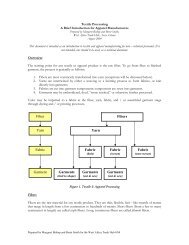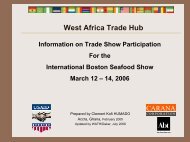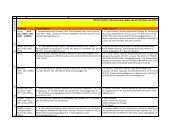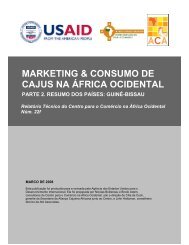Shea Butter A Guide to Production and Marketing - AGOA Export ...
Shea Butter A Guide to Production and Marketing - AGOA Export ...
Shea Butter A Guide to Production and Marketing - AGOA Export ...
Create successful ePaper yourself
Turn your PDF publications into a flip-book with our unique Google optimized e-Paper software.
Peace Corps Ghana Version 1, March 2008<br />
The number one concern for international buyers is “perceived quality” before price.<br />
For edible products the major market is in Europe <strong>and</strong> India <strong>and</strong> the butter extraction<br />
<strong>and</strong> refining is done there. The major cosmetic <strong>and</strong> soap industry is in the United<br />
States <strong>and</strong> is known as the most lucrative global shea butter market. The majority of<br />
shea butter consumed internationally is mixed in<strong>to</strong> a finished product containing a<br />
percentage of shea butter. The finished products in North America tend <strong>to</strong> have high<br />
tech containers <strong>and</strong> extensive marketing campaigns behind them <strong>and</strong> are high end<br />
products. Less than ten percent is used by the final consumer in its raw form.<br />
<strong>Shea</strong> nuts grow in 20 countries in the world, all of which are in Africa. The <strong>Export</strong><br />
season is from August <strong>to</strong> April each year. It is estimated that 150,000 – 200,000<br />
<strong>to</strong>nnes of nuts are exported each year from West Africa, 50,000 <strong>to</strong>nnes (approx. 33%)<br />
coming from Ghana alone. The nuts are shipped out of West Africa mainly from<br />
ports in Dakar, Senegal, Lome, Togo <strong>and</strong> Tema, Ghana.<br />
4: The <strong>Shea</strong> Value Chain<br />
What’s a Value Chain?<br />
PCVs see shea butter at both extremes. Here in Ghana, we see it in the form of balls<br />
of local butter sold for around GH 0.50. In the US, we saw fancy cosmetic products<br />
sitting on supermarket shelves that sold for around $20. Where is that value added <strong>to</strong><br />
the product? Who is making that profit?<br />
It will help <strong>to</strong> look at the shea butter value chain. A Value Chain includes all those<br />
groups involved at different levels of producing a single product. When considering<br />
shea, the members in a value chain are usually as follows:<br />
Nut<br />
Producers<br />
Nut<br />
Traders<br />
<strong>Butter</strong><br />
Producers<br />
Each member of the chain affects the product. Each member also depends on the<br />
other members of the chain for supply <strong>and</strong> income. A chain is not supposed <strong>to</strong> be<br />
intra-competitive. Instead, the entire chain functions in union <strong>to</strong> compete with other<br />
chains (e.g. in other countries/markets). The value of the product is shared along the<br />
chain, meaning each member of the chain receives some income for their work. That<br />
causes the increase in price from local <strong>to</strong> foreign markets<br />
Strengths <strong>and</strong> Weaknesses of a Value Chain<br />
Although the members of the Value Chain are not intended <strong>to</strong> compete, the system is<br />
not perfect. Each member will have needs that counter the needs of other members.<br />
Page 11 of 28<br />
<strong>Butter</strong><br />
Traders<br />
Nut <strong>and</strong><br />
<strong>Butter</strong><br />
<strong>Export</strong>ers<br />
Producers<br />
of Food <strong>and</strong><br />
Cosmetics


